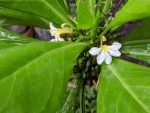 Also known as beach cabbage and sea lettuce, beach naupaka is a dense, spreading evergreen shrub growing 3-10’ tall. The medium green leaves are elliptical, waxy, fleshy, smooth and 1.5 to 8 inches long. The fragrant, white to cream colored flowers appear in clusters of three all year around and may be blushed with pink, purple, or violet. They have five petals all positioned on one side of the flower as though half of the petals had been torn off. The fruits are fleshy white to greenish white berries with a corky exterior that allows them to float for up to a year and facilitates their dispersion by ocean currents. Plants are used to prevent coastal erosion, protect cultivated plants from the salt spray, to enhance the beach landscape, and in Hawaii the flowers are used to make leis. Beach naupaka is native to beaches and tropical coastal habitats such as salt marshes, mangroves and sand dunes of the Indo-Pacific including Hawaii. It was introduced into Florida and has become invasive there, quickly forming extensive colonies and directly competing with the native inkberry, Scaevola plumier. The plants produce seed almost year around starting in their first or second year and the seed are widely dispersed by ocean currents. Broken branches or roots easily reproduce new plants making manual removal difficult. Herbicides have been effective in dry sites but are not useful in wet sites such as intertidal areas. USDA Hardiness Zones 10-11
Also known as beach cabbage and sea lettuce, beach naupaka is a dense, spreading evergreen shrub growing 3-10’ tall. The medium green leaves are elliptical, waxy, fleshy, smooth and 1.5 to 8 inches long. The fragrant, white to cream colored flowers appear in clusters of three all year around and may be blushed with pink, purple, or violet. They have five petals all positioned on one side of the flower as though half of the petals had been torn off. The fruits are fleshy white to greenish white berries with a corky exterior that allows them to float for up to a year and facilitates their dispersion by ocean currents. Plants are used to prevent coastal erosion, protect cultivated plants from the salt spray, to enhance the beach landscape, and in Hawaii the flowers are used to make leis. Beach naupaka is native to beaches and tropical coastal habitats such as salt marshes, mangroves and sand dunes of the Indo-Pacific including Hawaii. It was introduced into Florida and has become invasive there, quickly forming extensive colonies and directly competing with the native inkberry, Scaevola plumier. The plants produce seed almost year around starting in their first or second year and the seed are widely dispersed by ocean currents. Broken branches or roots easily reproduce new plants making manual removal difficult. Herbicides have been effective in dry sites but are not useful in wet sites such as intertidal areas. USDA Hardiness Zones 10-11
The following natives are recommended as alternatives:
Seven-Year Apple (Casaesia clusiifolia)
This evergreen shrub or small tree native to coastal areas of Florida grows up to 20’ tall and combines high salt tolerance with beautiful glossy, leathery foliage and fragrant white flowers tipped with pink in spring and early summer. USDA Hardiness Zones 10-11.
Southern Wax Myrtle (Morella cerifera aka Myrica cerifera)
Growing up to 15’ tall, southern wax myrtle is an evergreen large shrub or small tree and is native to wetlands, riparian sites, sand dunes, fields, hillsides, and pine barrens from New Jersey south to Florida, west to the lower Mississippi Valley and Texas. It has aromatic olive green leaves and fragrant but non-showy flowers. USDA Hardiness Zones 7-10
Rapanea (Myrsine quianensis)
Native to wet sites in Florid and the Caribbean, rapanea is an evergreen shrub growing 15-20’ tall and valued for its smooth green foliage. The inconspicuous flowers are followed by attractive, shiny, black berries. USDA Hardiness Zones 10-11
Inkberry (Scaevola plumier)
Inkberry is an evergreen mounding shrub growing 2-6’ tall with fleshy deep green leaves, inconspicuous flowers, and glossy black fruit. It is native to Florida, Louisiana, and Texas. USDA Hardiness Zones 10-11